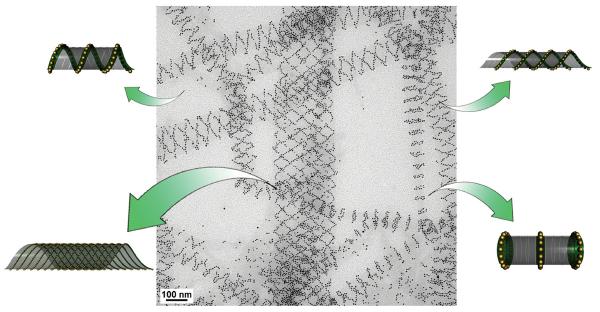"The ability to build predicted structures and provide experimental feedback to current theories is critical to the nanotechnology field," said Yan.
One approach to production of nanoscale architecture is creation of nanoparticles that assemble themselves into the desired structure. DNA molecules are an elegant biological example of small particles that self-assemble to form higher order 3D structures.

The design of the DNA scaffold system permits formation of a variety of tubular structures carrying 5 nm AuNPs (gold particles). Researchers observed formation of tubes displaying patterns of AuNPs in stacked rings, single spirals, double spirals, and nested spiral tubes. This TEM image shows all four of these conformations.Credit: Hao Yan, Arizona State University
Inspired by this prototype, Yan and colleagues looked to Mother Nature to solve their nano-sized problem. They attached gold nanoparticles to DNA, taking advantage of its self-assembling biochemical properties to engineer nanotubes that form a number of different 3D structures. The researchers manipulated nanotube size and shape by changing the size of the gold particles attached to the DNA or the DNA structure itself. Anchi Cheng at the Scripps Research Institute contributed to the project by imaging the 3D conformations of nanotube structures using cryo-Electron Tomography
Yan is hopeful this groundbreaking work will serve as the foundation on which emerging fields and new technologies may be built. "Now that we have methods to alter the periodicity, diameter and chirality of nanotube formation, we can use what we have learned to control hierarchical assembly of these building blocks to create more complex 3D structures," he said.
In the future, use of nanotubes may reduce the size of cell phones and other electronic devices even further. Scientists also envision using nanotubes for a number of biological applications including gene and drug delivery. Drugs or other treatments specifically delivered using nanotubes would target only affected tissues, potentially eliminating toxic side effects.
Funding from the National Science Foundation.




Comments